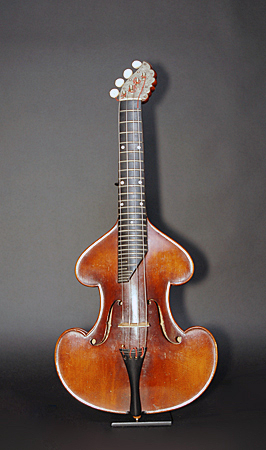
Owner: HWMC
Catalog#: CL-CHZT-03
Zithers
Johann Bucher ‘Streich-Melodeon’
Vienna, Austria
Ignaz Johann Bucher
Spruce, maple, ivory, ebony, brass
ca. 1858-1868
Length: 24 inches; Width: 10.5 inches
Strings – Zithers
Inscribed inside the zither: “Ig. Joh. Bucher, fecit Vienna”
The Austrian bowed zither, a shallow sound-box in the shape of a modified viol form is called a Bow-Melodion (Streich-Melodeon). It has sloping shoulders, an exaggerated waist, an ebony finger-board with twenty-nine brass frets and three ivory pegs at the back, serving to support the instrument on a table. The back and belly have overhanging edges as on violins and the neck and peg-plate are made of maple.
The Streich-Melodeon evolved from the “Alpine” folk zithers that developed into concert instruments in Austro-Germany in the 19th century. The first one appeared in 1823 when performed on by zither virtuoso Johann Petzmayer of Munich. It was a roughly heart-shaped instrument of flat construction with three strings. Later he increased it to four strings, which became standard on nearly all forms of bowed zithers. (Also found in this collection) This bowed zither by Bucher shows the characteristic metal fretted fingerboard, which on a regular zither is down the left side of the instrument. (See Franz Schwarzer zither in this collection) Playing this instrument involves the zither resting flat on a table top (sometimes referred to as a ‘table violin’) or on one’s lap; the right hand bows the strings, while the left hand frets the fingerboard. This method of playing is probably what justifies it being designated a zither, rather than a violin. The bowed-melodion is tuned like a violin, only backwards, which is the traditional tuning of the common alpine zither fretboard’s melody strings: e” a’ d’ g.
Ignaz Johann Bucher (1828 – 1881) was known as a violin maker in Vienna, Austria.
